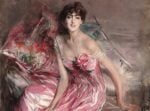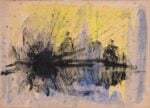Giuseppe Caccavale – Carmi Figurati
 (640x427).jpg)
Progetto site specific Carmi Figurati di Giuseppe Caccavale a cura di Chiara Bertola.
Comunicato stampa
La galleria Doppelgaenger è lieta di invitarvi il 30 ottobre 2019 alle ore 19 al progetto site specific Carmi Figurati di Giuseppe Caccavale a cura di Chiara Bertola.
Sulle pareti della galleria Giuseppe Caccavale ‘traduce’ in figure le parole che il grande poeta russo Osip Mandel’stam ha dedicato a Dante nella sua nota Conversazione; a queste unisce i versi delle poesie “Ottave” sempre di Mandel’stam e, tra parole e figure disegnate, fa risuonare insieme anche le immagini di alcune fotografie scattate in Armenia e che da sempre sono parte integrante della sua opera.
Ha dipinto di blu ceruleo le pareti della galleria portando all’interno l’aria e dilatando lo spazio come se si aprisse una volta celeste o piuttosto, come scrive l’artista stesso, un “palato celeste”. Sopra vi ha disegnato con il pastello grasso grandi figure ispirate dall’opera dei monaci benedettini e artisti Rabano Mauro e Opicino de Canistris e con il pastello secco, come un cartiglio apposto sopra, ha disegnato le parole tratte dalla “Conversazione su Dante” dandogli corpo e figura.
Un progetto in cui l’artista fa tornare i conti di un lungo lavoro di studio e visioni che da anni porta avanti anche attraverso il suo compito di docente alla Ècole Nationale Superieure des Arts Décoratifs di Parigi.
Nell’ampio spazio della Galleria, ogni elemento, ogni immagine, parola, rima, figura, associazione è connessa nel grande affresco ora composto sui muri. Si tratta di una costellazione di "carmi figurati" dove “tutto” risuona e si connette tra un tempo e l’altro della storia, tra le vite di due poeti che hanno condiviso l’esilio nella propria patria. Un tema oggi attuale e vivo, e la sua riproposizione da parte di un artista come Caccavale, che da tanti anni ha trovato accoglienza in Francia, apre ancora un significato ulteriore e forte: a volte si tratta di un esilio dal proprio tempo, di una sensibilità che costringe a essere randagi per continuare a vivere.
Da qualche anno questo artista ha scelto di confrontarsi con la parola dei poeti perché ha intuito che la parola poetica è complessa e la sua verità non sta nell’immediatezza, ma nella vita attraverso il tempo. Anzi modifica il tempo perché è in grado di unire il passato e il futuro. Oggi le parole sono leggere, sempre più virtuali: non hanno peso e spariscono anche soltanto sfiorando un tasto o toccando uno schermo. Sono moltiplicabili, riproducibili, copiabili e modificabili. Giuseppe Caccavale decide invece di inciderle e disegnarle sui muri. Le ingigantisce in grandi disegni con la grafite; gli da casa e le fa riemergere dentro un nuovo linguaggio.
Sui muri, dunque, solo parole e figure si rivelano al nostro sguardo. “Nessuna lezione stilistica, nessun modo di vedere. Libri a cielo aperto per guardare ad alta voce, per mettere voce agli occhi.” Questo il progetto che Giuseppe Caccavale ha pensato appositamente per la Galleria Doppelgaenger di Bari trasformandola “in una scuola senza banchi, una scuola dove si sta in piedi e si fanno scalare gli occhi sulle pareti della meraviglia, la meraviglia di essere al servizio di un compito per gli altri. Noi diamo disegno alle parole per incontrare di nuovo Dante. Non in Inferno, non in Purgatorio, non in Paradiso... a casa.”
Dal dialogo nel catalogo tra Chiara Bertola, curatrice della mostra e Giuseppe Caccavale: “Per te una lettera, una parola è un oggetto. Sei arrivato a una sintesi incredibile e a me sembra di avere davanti la stessa magnifica ossessione che aveva Cezanne quando guardava e dipingeva la Sainte Victoire con la stessa dedizione con la quale Morandi dipingeva le sue bottiglie. Che cosa sono per te le parole di Mandel’stam? Mi sembra infatti che le poesie di Mandel’stam siano la tua Saint Victoire e le tue bottiglie...” “Mi piace pensare che mi metto di fronte a una poesia come il geologo Paul Cezanne si metteva di fronte alla sua montagna Sainte Victoire in Provenza, allo stesso modo sembra di disegnare e scavare lettere nei muri come Giorgio Morandi dipingeva i suoi oggetti. Ho incontrato la poesia del poeta russo Osip Mandel'stam leggendo il poeta di lingua tedesca vissuto a Parigi, Paul Celan. Erano gli inizi degli anni novanta, ero a Gand nelle Fiandre per studi intorno al Canto e ai Primitivi Fiamminghi.”
Giuseppe Caccavale, ha studiato all'Accademia di Belle Arti di Napoli, a Gand nelle Fiandre e ha trascorso soggiorni di studi al Monte Athos in Grecia. Insegna Arti Murali e Poetica degli spazi all'Ecole Nationale Supérieure des Arts Décoratifs di Parigi.
Ha rappresentato l'Italia alla 56ma Biennale di Venezia nel 2015, ha realizzato il graffito "Viale dei Canti" all'Istituto Italiano di Cultura di Parigi, nel 2016. Ha partecipato a "Standart" Triennale Internazionale d'Armenia, a cura di Adelina von Furstenberg, nel 2017. Per il Ministero alla Cultura e la Fondazione Spinola Banna per l'Arte ha realizzato con il compositore Stefano Gervasoni un progetto per una riqualificazione urbana per la Città di Torino, 2017-2018. Suoi lavori in vetro sono stati presentati nella mostra: "Cirva, una fornace a Marsiglia", alla Fondazione Querini Stampalia e Stanze del Vetro, Venezia 2018.
Di recente ha pubblicato per le edizioni Parentheses di Marsiglia: "Armenia-Ossip Mandelstam", disegni.
Suoi lavori sono presenti nelle collezioni della Biblioteque Nationale de France. FRAC - Alpes Côté d'Azur. MAC - Musee d'Art Contemporaine, Marseille. MAXXI - Museo Nazionale della Arti del XXI secolo, Roma. MACRO, Museo d'Arte Contemporanea, Roma. Museo Madre, Napoli.
*
On 30 October 2019 Doppelgaenger Gallery is pleased to invite you to the opening at 7pm of the one–man show by Giuseppe Caccavale Figure Poems curated by Chiara Bertola.
On the walls of the gallery space Caccavale “translates” in figures the words that the great Russian poet Osip Mandel’stam dedicated to Dante in his well known Conversations. To these figures he unites verses from Mandel’stam’s poems in “Octaves”; and between the words and figures drawn on the walls, he brings together images of photographs taken in Armenia, which have always been an integral part of his work.
He has painted the walls of the gallery a sky blue colour, bringing the fresh air inside and expanding the space, as if a celestial vault had opened up, or, in the words of the artist himself, a “celestial palate”. On the blue he has drawn large figures in oil pastels inspired by the works of the Benedictine monks and artists Rabano Mauro and Opicino de Canistris, and in hard pastels, like a superimposed cartouche, he has drawn the words taken from Conversation on Dante giving them shape and form.
A project in which the artist brings to fruition a long studio undertaking and visions expressed for years through his teachings at the École Nationale Superieure des Arts Décoratifs in Paris as well.
In the ample space of the gallery, every element, every image, word, rhyme, figure, association, is connected in the grand fresco now taking shape on the walls. A constellation of “figure poems” where “everything” resonates and connects between one historical time and another, between the lives of two poets who shared a condition of exile in their own homeland. A theme alive and relevant today, whose re–presentation by an artist like Caccavale – who has found refuge for many years in France – opens up a further powerful significance: sometimes it’s a matter of being an exile from one’s own time, of a sensibility that makes us strays in order to continue living.
For some years now, the artist has chosen to challenge himself with the words of poets, because he has gleaned that the poetic word is complex, and its truth lies not in immediacy, but in life over time. Indeed, it changes time, because it unites past and future Today words are light, because they are written virtually, they have no weight and they disappear with the touch of a button or a screen. They can be multiplied, reproduced, copied, and modified. Giuseppe Caccavale, on the other hand, has decided to engrave and draw them on walls. He enlarges them in monumental graphite designs; he gives them a home and lets them emerge within a new language.
On the walls, therefore, only words and figures reveal themselves to our gaze. “No lesson in style, no way of seeing. But books opened to the sky in order to see ‘out loud’, in order to give voice to the eyes.”
The project has been conceived by Caccavale specifically for Doppelgaenger Gallery in Bari, transforming it into “a school without desks, a school in which we are standing, in which our eyes scale the walls of the marvellous, the marvel of being in the service of a task for others. We give shape and form to words in order to rediscover Dante. Not in Hell, nor in Purgatory, nor in Paradise…but at home.”
In the dialogue published in the catalogue, between Chiara Bertola, exhibition curator, and Giuseppe Caccavale, we read:
For you a letter, a word, is an object. You have arrived at an incredible synthesis and it seems to me that I see the same magnificent obsession that Cezanne had when he looked at and painted Saint Victoire, the same dedication with which Morandi painted his bottles. What led you to the relation with Mandelstam's words? It seems to me that Mandelstam's poems are your Sainte Victoire and your bottles. You treat them like objects ...
I like to think that I place myself before a poem just as the geologist Paul Cezanne placed himself in front of Sainte Victoire mountain in Provence; likewise, it seems to me that I draw and excavate letters on a wall just as Giorgio Morandi painted his objects. I discovered the work of the Russian poet Osip Mandelstam by reading the German–speaking poet, Paul Celan, who lived in Paris. It was the beginning of the nineties, I was in Ghent in Flanders to study Canto and the Flemish Primitives.
Giuseppe Caccavale, studied at the Academy of Fine Arts in Naples, in Ghent in Flanders and spent his studies at Mount Athos in Greece. He teaches Mural Arts and Poetics of Spaces at the Ecole Nationale Supérieure des Arts Décoratifs in Paris.
He represented Italy at the 56th Venice Biennale in 2015, created the graffiti "Viale dei Canti" at the Italian Cultural Institute in Paris, in 2016. Giuseppe Caccavale also participated in the "Standart" International Triennial of Armenia, curated by Adelina von Furstenberg, in 2017. For the Ministry of Culture and the Fondazione Spinola Banna per l'Arte, he created a project for urban renewal for the City of Turin, 2017-2018, with the composer Stefano Gervasoni. His works in glass were presented in the exhibition: "Cirva, a furnace in Marseille", at the Querini Stampalia Foundation and Stanze del Vetro, Venice 2018.
Recently he has published "Armenia-Ossip Mandelstam", drawings, for Parentheses editions, Marseille.
His works are present in the collections of the Biblioteque Nationale de France. FRAC - Alpes Côté d'Azur. MAC - Musee d'Art Contemporaine, Marseille. MAXXI - National Museum of Arts of the XXI century, Rome. MACRO, Museum of Contemporary Art, Rome. Museo Madre, Naples.



